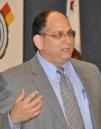The Road Not Paid For
Robert Frost wrote about the Road Not Taken—I will set my literary sights a little lower, and write about the Road Not Paid For.
Two roads diverged in my neighborhood, And sorry I could not pay for both, To be one community long we would, Borrow to pay for them as best we could, And hope that revenue would rise with growth,
But look at another, it also needs, And having perhaps the better claim, For maintenance and other deeds, We hope that congress hears and heeds, The pleas for help we now proclaim,
For both this morning equally seek, The pavement and bridges lack, Years of work to stem the leak, Of rust and ruin they do so reek, T’is mere billions we now so lack,
I shall be telling this with a sigh, Somewhere else this may be fun, Two roads diverged in need and I, Took the one not paid for by, And now wish we’d enhanced MAP 21,
And all of that is my attempt at making a serious subject a little more approachable. But the truth is, when budgets get tight, like they have been for the past several years, funding for local road maintenance is an easy thing for the state and federal governments to cut. But now the deferred maintenance on local roads and bridges has been adding up for years, and the result is the focus of a new report out from the National Association of Counties (NACo) called The Road Ahead: County Transportation Funding and Financing.
The Executive Summary reads in part:
“Federal and state funding for county transportation projects is increasingly inadequate. Based on Federal Highway Administration data, the share of federal and state funding to local governments for highways decreased by 10 percent between 1998 and 2011.The latest federal surface transportation law, Moving Ahead for Progress in the 21st Century Act (MAP-21), further skewed the allocation of funds away from local governments.”
I am just beginning to learn about MAP 21. I gather that between State and Federal sources, we have been able to maintain historical funding levels for local roads and bridges in California. But the problem is, while the funding has remained flat the miles traveled on those roads and the cost of maintaining them have both increased. I also learned that MAP 21 expires later this year, and that possibly provides an opportunity to expand or enhance it’s funding for local roads and bridges.
Thankfully, CSAC has some subject matter experts who live and breathe this stuff. They will be going to Washington DC next week to talk to our congressional delegation about a lot of issues including MAP 21. In this contentious election year, it may be hard for Congress to pass a new and possibly better Transportation Bill. A continuing resolution that keeps things as they are for another year is more likely. But this trip to the Nation’s Capital is important—Frost might have been able to choose “The Road Not Taken” but not even he could travel the road not paid for.












































